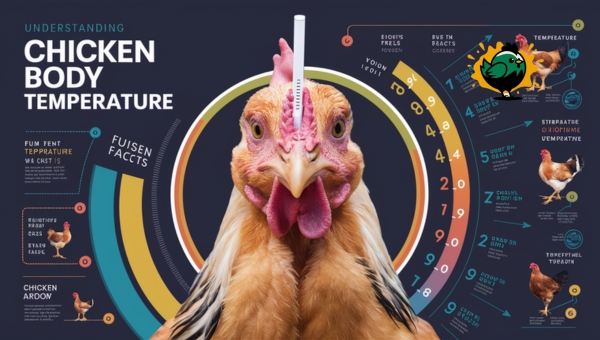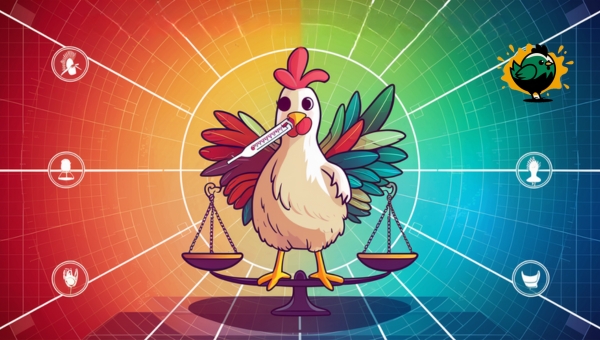Chicken Body Temperature | The Secret to Healthy Flocks

A bustling poultry farm, where chickens cluck contentedly under the warm sun. This scene is more than picturesque; it hinges on understanding chicken body temperature. Monitoring body temperature is crucial for maintaining a healthy flock. Chickens, like humans, have specific temperature needs that ensure their vitality.
If these needs are unmet, it can lead to health issues. Whether you’re an experienced farmer or a beginner, understanding these temperature nuances can make all the difference. In the following sections, we’ll delve into the essentials of chicken body temperature, offering practical insights to keep your flock thriving.
Understanding Chicken Body Temperature
Chicken body temperature is an essential aspect of poultry health management. Chickens, like other avian species, are warm-blooded creatures. This means they maintain a relatively stable body temperature, unlike cold-blooded animals whose temperature fluctuates with the environment.

The typical body temperature for a healthy chicken ranges from 105°F to 107°F (40.5°C to 41.7°C). Maintaining this temperature is crucial for their metabolic processes and overall well-being.
- Metabolic Rate: Chickens have a high metabolic rate, which supports their warm-blooded nature. This high metabolism generates heat, contributing to their body temperature. This process is crucial for their growth, egg production, and immunity.
- Thermoregulation: Chickens have several mechanisms to regulate their body temperature. One significant method is panting, which helps them cool down through evaporative cooling. They might also adjust their activity level or seek shade to manage temperature changes.
- Feather Insulation: Feathers play a vital role in maintaining chicken body temperature. They provide insulation, trapping heat close to the body in cold conditions, and can be fluffed up or smoothed down to adjust to environmental changes.
- Blood Flow Regulation: Chickens can alter blood flow to their extremities to manage heat loss. During hot weather, increasing blood flow to the comb and wattles helps dissipate heat.
- Environmental Influence: Although chickens can maintain their body temperature, extreme environmental conditions can impact their ability to do so. Adequate shelter and ventilation are essential to support their natural thermoregulation processes.
Understanding these aspects of chicken body temperature helps in ensuring their health and productivity. Proper management practices, including observing their behavior and providing suitable environmental conditions, are vital for maintaining optimal temperatures in poultry.
Factors Influencing Chicken Body Temperature
Understanding the various elements that affect chicken body temperature is crucial for maintaining their health and well-being. Several factors come into play, including environmental conditions, health and nutrition, and breed variations.

Each of these aspects can significantly impact how chickens regulate their body temperature, ultimately influencing their overall health.
Environmental Conditions
Climate and weather have a direct effect on a chicken’s body temperature. Here are some key points:
- Temperature fluctuations: Extremes in weather, such as heatwaves or cold snaps, can lead to stress, affecting a chicken’s ability to maintain a stable body temperature.
- Humidity levels: High humidity can make it difficult for chickens to cool down, while low humidity may cause dehydration.
- Wind exposure: Wind can either cool chickens down or, in cold conditions, contribute to heat loss.
Health and Nutrition
A chicken’s diet and overall health play a vital role in temperature regulation. Consider these aspects:
- Balanced diet: Proper nutrition ensures that chickens have the energy to maintain body heat, especially in colder climates.
- Hydration: Adequate water intake is essential for temperature regulation, as dehydration can lead to overheating.
- Health status: Illness or parasites can disrupt a chicken’s ability to control its body temperature effectively.
Breed Variations
Different breeds of chickens may have varying body temperatures. Key points include:
- Genetic differences: Some breeds, especially those adapted to specific climates, may naturally have higher or lower body temperatures.
- Feather density: Breeds with denser feathers may retain heat better, affecting their temperature regulation.
- Size and metabolism: Smaller breeds or those with faster metabolisms may experience different temperature dynamics compared to larger breeds.
Understanding these factors is essential for anyone involved in poultry farming or chicken care, as it helps in creating optimal living conditions for these birds.
Also Read: Chicken Dust Bath – Essential Guide for Happy Hens
Monitoring Chicken Body Temperature
Keeping tabs on chicken body temperature is crucial for ensuring their health and well-being. By regularly monitoring their temperature, farmers can detect any potential health issues early on.

There are several tools and techniques to effectively monitor chicken temperatures, and it’s important to know the signs of abnormal temperatures to address any concerns promptly.
Tools and Techniques
To effectively monitor chicken body temperature, a few reliable tools and techniques can be employed:
- Digital Thermometers: These are commonly used due to their accuracy and ease of use. They are inserted gently to get a reading.
- Infrared Thermometers: Useful for non-contact temperature readings, especially helpful when dealing with large flocks.
- Thermal Cameras: These provide a visual representation of temperature variations across the flock, identifying hot or cold spots without direct contact.
- Regular Checks: Consistent monitoring is key, so setting a routine for temperature checks can help maintain a healthy environment.
Signs of Abnormal Temperature
Recognizing signs of abnormal chicken body temperature is important for timely intervention:
- Lethargy: Chickens appear tired or less active than usual.
- Panting or Rapid Breathing: Indicates overheating or distress.
- Shivering: A sign that chickens might be too cold.
- Changes in Appetite: Either reduced or increased intake can suggest temperature issues.
- Feather Ruffling: Chickens may fluff their feathers to regulate body temperature.
By being vigilant and using the right tools, poultry farmers can ensure their chickens remain healthy and thriving. Regular monitoring paired with understanding the signs helps to prevent potential health issues effectively.
Managing Temperature in Poultry Farming
Managing temperature in poultry farming is crucial for the well-being and productivity of chickens. With the right strategies, farmers can ensure that their flocks remain healthy and comfortable.

Let’s explore some key aspects, including housing design and various temperature control strategies, to maintain optimal conditions in poultry environments.
Housing and Ventilation
The design of poultry housing plays a vital role in regulating temperature. Proper ventilation is essential to maintain a stable and healthy environment.
Here are some important considerations:
- Insulation: Good insulation helps keep the temperature stable, protecting against extreme weather conditions.
- Ventilation Systems: Installing fans or vents can aid in circulating fresh air, preventing heat buildup.
- Orientation: Positioning the housing to take advantage of natural wind patterns can enhance airflow.
- Materials: Using materials that reflect heat rather than absorb it can help in keeping the temperature down.
Temperature Control Strategies
Various strategies can be employed to maintain the right temperature for poultry health. These strategies help in adapting to different environmental conditions:
- Cooling Systems: Implementing misters or evaporative cooling systems can reduce heat stress in chickens.
- Heaters: In colder climates, providing heaters or heat lamps ensures that chickens remain warm.
- Automated Climate Control: Utilizing technology to monitor and adjust temperatures can lead to more efficient management.
- Regular Monitoring: Keeping a close watch on temperature changes and making adjustments as needed can prevent health issues.
By focusing on these aspects, poultry farmers can create an environment that supports the health and productivity of their chickens.
Also Read: Vitamins for Chicken – Boosting Poultry Health
Common Temperature-Related Health Issues
When it comes to poultry, maintaining the right body temperature is crucial for their well-being. Chickens can face various health challenges related to temperature fluctuations.
Understanding these issues can help in preventing potential health risks. Here, we delve into two common temperature-related conditions: hypothermia and hyperthermia.
Hypothermia
Hypothermia in chickens occurs when their body temperature drops below the normal range. It’s important to recognize this condition early to prevent severe health consequences.
- Causes:
- Exposure to cold weather or drafts
- Lack of adequate bedding or shelter
- Poor feather condition, which impairs insulation
- Symptoms:
- Lethargy and inactivity
- Shivering or fluffing up feathers
- Pale comb and wattles
- Prevention Strategies:
- Ensure proper insulation in coops to block drafts
- Provide extra bedding during cold weather
- Regularly check and maintain good feather health
Hyperthermia
Hyperthermia is the result of chickens’ body temperature rising above the normal level, often due to external heat sources.
- Causes:
- High ambient temperatures or heatwaves
- Overcrowded living conditions reduce airflow
- Lack of access to cool water
- Symptoms:
- Panting or open-mouth breathing
- Extended wings away from the body
- Lethargy and disinterest in food
- Treatments:
- Offer plenty of fresh, cool water
- Provide shaded areas or fans to reduce heat
- Ensure proper ventilation in housing to promote air circulation
Understanding these temperature-related health issues can greatly improve the care and management of chickens, ensuring they remain healthy and productive.
FAQs
What is the normal body temperature of a chicken?
The normal body temperature of a chicken typically ranges from 105°F to 107°F. Maintaining this temperature is crucial for their overall health and productivity.
How does weather affect chicken body temperature?
Weather can significantly impact a chicken’s body temperature. Extreme temperatures, whether hot or cold, can stress chickens and lead to health problems.
Can diet influence a chicken’s body temperature?
Yes, diet plays a role in regulating a chicken’s body temperature. Proper nutrition ensures that chickens have enough energy to maintain their body temperature.
Are there differences in body temperature among chicken breeds?
Different breeds can show variations in body temperature. Some breeds are more tolerant to temperature changes due to their genetic makeup.
How can I monitor my chicken’s body temperature?
You can use digital thermometers specifically designed for poultry to monitor their temperature. Regular checks help ensure that chickens remain healthy.
What are the signs of abnormal body temperature in chickens?
Signs of abnormal body temperature include lethargy, unusual behavior, and changes in appetite. It’s important to address these signs promptly to prevent health issues.
Conclusion
Understanding chicken body temperature is crucial for ensuring the health and productivity of poultry. By being aware of the factors influencing temperature, such as environmental conditions, health, nutrition, and breed variations, farmers can monitor and manage their flocks effectively.
Utilizing appropriate tools and techniques helps in identifying any abnormalities early on. Proper housing, ventilation, and temperature control strategies play a significant role in maintaining optimal conditions. Recognizing and addressing common temperature-related health issues like hypothermia and hyperthermia can prevent potential problems.
For more insights into poultry farming, explore our other informative articles to enhance your knowledge and skills!
